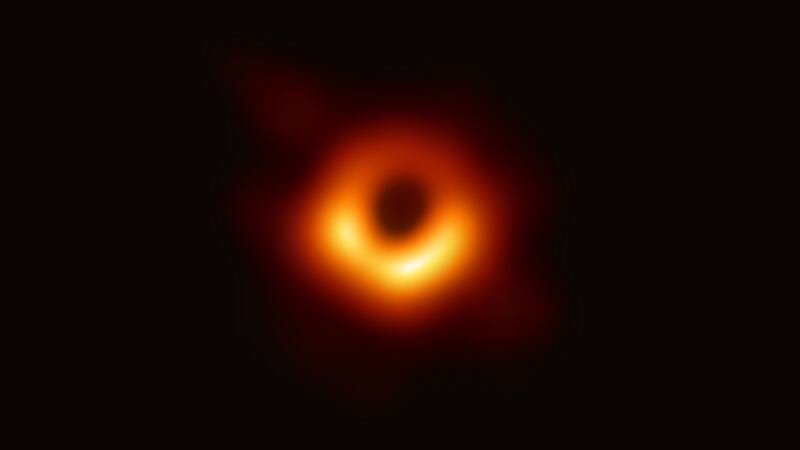The glowing doughnut lost in the vastness of space looks harmless enough – but it is just as well the object is 55 million light years away.
This is the first image astronomers have captured of a supermassive black hole big enough to swallow stars at the centre of a distant galaxy.
Nothing that gets too close to the monstrous gravitational vortex can ever escape – not even light.
But at the “point-of-no-return” precipice around its edge – the boundary scientists call the Event Horizon – hot gas, matter and radiation rage in a swirling eddy.
While a black hole itself is by its nature invisibly dark, astronomers can observe the Event Horizon maelstrom with sufficiently powerful instruments.
The image of the supermassive black hole at the core of galaxy M87 was obtained by combining eight radio dishes around the world into one global telescope.
It shows a thick ring of light surrounding a dark centre.

Nothing like this photo has ever been obtained before. Previously, scientists have only been able to visualise black holes in simulations.
Katie Bouman, the MIT graduate student who led the development of the new algorithm to help produce the new image, likened it to “taking an image of a grapefruit on the moon, but with a radio telescope”.
In 2012 astronomers from Johns Hopkins University in the US published images of a black hole 2.7 million light years away gobbling up a Red Giant star – but it was nothing more than a tiny smudge of light.
At one of six press conferences around the world announcing the landmark results from the Event Horizon Telescope (EHT) project, Dr Sheperd Doelman, from Harvard University in the US, said: “We have seen what we thought was unseeable. We have seen and taken a picture of a black hole.
“This is a remarkable achievement. We now have visual evidence of a black hole. This is the strongest evidence that we have to date of the existence of black holes.”
In April 2017, the EHT dishes “swivelled, turned and stared” at M87, said Dr Doelman.
The radio telescopes were also pointed at a supermassive black hole at the centre of our own galaxy, the Milky Way – an energy source known as Sagittarius A (SgrA).

Prior to the announcement there had been speculation that images of SgrA would provide the most dramatic results.
But in fact it was the M87 black hole that stole the show. The size of the object almost defies the imagination – it contains 6.5 billion times more mass than the sun.
Scientists gathered at the National Press Club in Washington DC explained that SgrA was a “complex” object and the M87 black hole had been easier to image.
They said they were hoping to release photos of SgrA soon but could make “no promises”.
The network of radio telescopes used to capture the image included dishes in Hawaii, Mexico, Spain, Chile and Antarctica.
Astronomers used a technique called very-long-baseline interferometry (VLBI) to synchronise the telescopes together.
Acting as one, they achieved a level of angular resolution equivalent to reading a newspaper in New York from a pavement cafe in Paris, France.
The dark centre of the glowing “doughnut” is in fact a shadow caused by the gravitational bending of light.
M87’s black is actually 2.5 times smaller than the shadow it casts.
This 17-minute film explores the efforts that led to this historic #RealBlackHole image, from the science of Einstein and Schwarzschild to the struggles and successes of the @ehtelescope collaboration. https://t.co/5heHB7Y6wZ
— ESO (@ESO) April 10, 2019
A British scientist involved in the project, Dr Ziri Younsi from the University College London Mullard Space Science Laboratory, said: “We have accomplished something many thought impossible by imaging the shadow of a black hole and it provides the strongest evidence to date that such evasive and enigmatic entities do indeed exist.
“It’s the closest we can get to imaging a black hole, which is an object with such a strong a gravitational field that no light or matter can escape.
“This observation lays the foundation for future studies of black holes and could play a crucial role in our understanding of the behaviour of light and matter in the most extreme environments in our universe.”
Black holes are created when massive stars die and collapse, crushing matter to an infinitely small space where the normal laws of physics no longer apply.
Weird things happen close to a black holes, which were predicted as long ago as 1915 by Albert Einstein in his theory of general relativity.
For objects approaching a black hole, time slows down and eventually grinds to a halt.
From the perspective of an astronaut caught in a black hole’s grip, it would take an infinitely long time to reach the Event Horizon.
Scientists hope results from the EHT project will help them marry together two apparently incompatible pillars of physics, Einstein’s theory of general relativity and quantum mechanics.
The first relates to laws of nature on cosmic scales while the second governs the strange world of subatomic particles.
M87, or Messier 87, is a “supergiant” elliptical galaxy in the nearby Virgo galaxy cluster.
One of its most notable features is a jet of fast atomic particles that shoots out of the galaxy and stretches across a distance of 5,000 light years.
Scientists believe the jet is powered by M87’s black hole.
American astrophysicist France Cordova, director of the US National Science Foundation, said: “This is a huge day in astrophysics ..
“Black holes have sparked imaginations for decades. They have exotic properties and are mysterious to us. Yet with more observations like this one they are yielding their secrets.”
Coinciding with the public release of the M87 image, six scientific papers were published in the Astrophysical Journal Letters.








